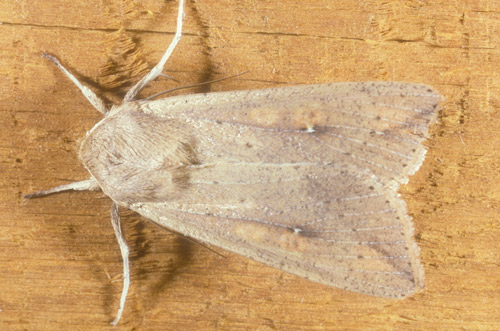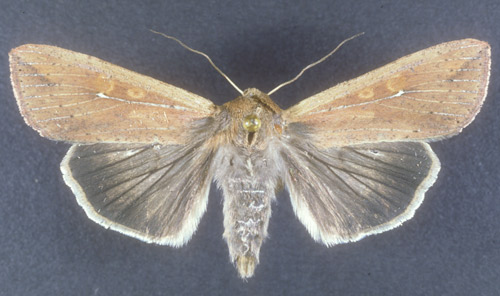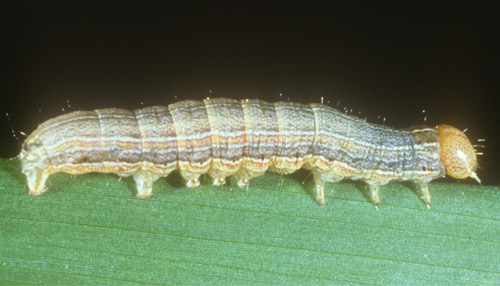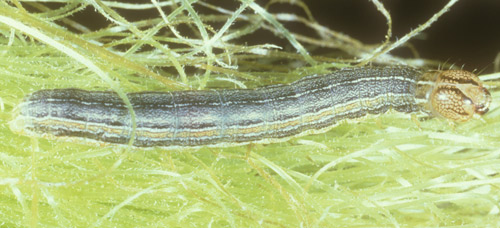common name: armyworm
scientific name: Mythimna unipuncta (Haworth) (Insecta: Lepidoptera: Noctuidae)
Introduction - Distribution - Description and Life History - Hosts Plants - Damage - Natural Enemies - Management - Selected References
Introduction (Back to Top)
The armyworm, Mythimna unipuncta (Haworth), is sometimes called true armyworm to distinguish it from other species that include armyworm in the common name. In Florida, Fall armyworm, Spodoptera frugiperda (J. E. Smith) is often called armyworm, and occurs frequently; in contrast, Mythimna unipuncta is not found frequently in Florida.
Figure 1. Adult armyworm, Mythimna unipuncta (Haworth). Photograph by John Capinera, University of Florida.
Distribution (Back to Top)
Armyworm occurs in many areas of the world, including North, Central and South America, southern Europe, central Africa, and western Asia.
In North America, it is most abundant east of the Rocky Mountains where it is known principally as a grain pest. It does not overwinter in northern latitudes, but disperses northward each spring, and then southward during the autumn. It has been known to be damaging in Florida, but only rarely.
Description and Life History (Back to Top)
Adults: The adults are light reddish brown moths with wing spans measuring about 4 cm. The forewing is fairly pointed, appearing more so because a transverse line of small black spots terminates in a black line at the anterior wing tip. The forewing is also marked with a diffuse dark area centrally containing one or two small white spots. The hind wings are grayish, and lighter basally. Adults are nocturnal.
Figure 2. Adult armyworm, Mythimna unipuncta (Haworth). Photograph by John Capinera, University of Florida.
Mating commences one to three days after moths emerge from the soil, and usually four to seven hours after sunset. Eggs are normally deposited within a four to five day period (range: one to 10 days). Females produces an average of 4.9 egg masses (range: one to 16 eggs). Reproductive capacity varies, with authors reporting mean egg production anywhere from 500 to 1500 per female. Feeding is necessary for normal oviposition.
Mean longevity at warm temperatures is about nine days in males and 10 days in females (range: three to three to 25 days) whereas at cool temperatures mean longevity of males is 19 days and females 17 days.
Eggs: Adult females deposit eggs in clusters consisting of two to five rows, in sheltered places on foliage, often between the leaf sheath and blade, especially on dry grass. Often females seem to deposit large numbers in the same vicinity, resulting in very high densities of larvae in relatively small areas of a field. Nevertheless, the eggs are very difficult to locate in the field.
The eggs are white or yellowish, but turn gray before immediately before hatching. Eggs are spherical, and measure about 0.54 mm (range 0.4 to 0.7 mm) in diameter. The egg surface appears to be shiny and smooth, but under high magnification fine ridges can be observed. The egg clutches are covered with an adhesive secretion that is opaque when wet but transparent when dry. As the adhesive material dries it tends to draw together the foliage, almost completely hiding the eggs.
Mean duration of the egg stage is about 3.5 days at 23°C, and 6.5 days at 18°C, but the range is three to 24 days over the course of a season. Hatching rates are affected by temperature, with cool weather more favorable for embryonic survival. In Tennessee, about 98% egg hatch occurs in early spring and autumn, with hatching rates dropping to less than 30% during the summer; this probably accounts for the evolution of the dispersal behavior in this species.
Larvae: Larvae normally display six instars, though up to nine instars have been observed. Mean head capsule widths (range) are 0.34 (0.30-0.37), 0.55 (0.49-0.63), 0.94 (0.83-1.12), 1.5 (1.29-1.70), 2.3 (2.08-2.56), and 3.3 (3.04-3.68) mm, respectively, for instars one through six. Head capsule widths increase slightly with increased temperature up to about 30°C.
Larvae attain a body length 4, 6, 10, 15, 20, and 35 mm, respectively, during instars one through six. Except for the first instar, which is pale with a dark head, the larvae of the armyworm are marked with longitudinal stripes throughout their development. The head capsule is yellowish or yellow-brown with dark net-like markings. The body color is normally grayish green or grayish brown, but a broad dark stripe usually occurs dorsally and along each side. A light subspiracular stripe often is found laterally beneath the dark stripe.
Figure 3. Curled larva of the armyworm, Mythimna unipuncta (Haworth). Photograph by Lyle J. Buss, University of Florida.
Figure 4. Larva of the armyworm, Mythimna unipuncta (Haworth). Photograph by John L. Capinera, University of Florida.
Development time varies with temperature. During summer, larvae complete their development in about 20 days, but this is extended to about 30 days during the spring and autumn, and greatly prolonged during winter. Instar-specific development times recorded during early summer in Tennessee are 2-3, 2-3, 2-4, 2-3, 4-5, and seven to 10 days for instars one through six, respectively.
The larvae tend to disperse upward following hatching, where they feed on tender leaf tissue. If disturbed, they readily extrude silk and spin down to the soil. Larvae in instars three through six are active at night, seeking shelter during the day on the soil beneath debris or clods of soil.
Although not surviving year-round in cold winter areas, larvae apparently overwinter at intermediate levels, and in warm weather areas all stages may be found during the winter. The number of generations varies among locations, but in North America two generations occur annually in Ontario, Canada, whereas in the USA there are two to three generations in Minnesota and New York, four to five generations are reported in Tennessee, and five to six in southern states. A complete generation requires 30 to 50 days.
Pupae: Larvae pupate in the soil, often under debris, at depths of 2 to 5 cm. Pupation occurs in an oval cell that contains a thin silken case. The pupa is moderate in size and robust, measuring 13 to 17 mm long and 5 to 6 mm wide. The pupa is yellowish brown initially, but soon assumes a mahogany brown color. The tip of the abdomen bears a pair of hooks. Duration of the pupal stage is seven to 14 days during summer but longer early and late in the season, sometimes lasting 40 days.
Hosts Plants (Back to Top)
Armyworm generally prefers to oviposit and feed upon plants in the family Gramineae, including weedy grasses. Thus, such grain and grass crops as barley, corn, millet, oats, rice, rye, sorghum, sugarcane, timothy, and wheat may be consumed, as well as wild or weed grasses. During periods of abundance larvae feed more generally, damaging such crops as alfalfa, artichoke, bean, cabbage, carrot, corn, celery, cucumber, lettuce, onion, parsley, parsnip, pea, pepper, radish, sugarbeet, sweet potato, watermelon, and others. Adults feed on nectar of various flowers and sometimes feed on other sweet foods such as ripe and decaying fruit.
Figure 5. Lateral view of the larva of the armyworm, Mythimna unipuncta (Haworth) on corn tassels. Photograph by Lyle J. Buss, University of Florida.
Damage (Back to Top)
Larvae initially skeletonize foliage, but by the third instar they eat holes in leaves, and soon afterwards consume entire leaves. Larvae of armyworm are notorious for appearing out of nowhere to inflict a high level of defoliation. This occurs for several reasons:
- a highly clumped distribution of young larvae, with most of the crop uninfested until larvae are nearly mature and highly mobile;
- a tendency by larvae to feed on grass weeds preferentially, only moving to crops after the grass is exhausted;
- occurrence of a preponderance of feeding, about 80%, in the last instar;
- the nocturnal behavior of larvae, which makes them difficult to observe during the day;
- and the gregarious and mobile behavior of mature larvae, which form large aggregations or bands (hence the common name ‘army' worm).
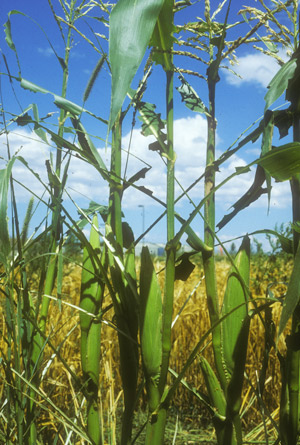
Figure 6. Armyworm, Mythimna unipuncta (Haworth), damage to corn foliage. Photograph by John L. Capinera, University of Florida
As previously noted, grasses and grains are preferred, but as these plants are consumed larvae disperse, often in large groups, to other plants. During outbreaks, few plants escape damage.
Natural Enemies (Back to Top)
The importance of natural enemies, especially parasitoids, has been studied, though nearly all data are derived from periods of high armyworm density, which is not typical for this insect. Over 60 species of wasp and fly parasitoids are known, and vary considerably from time to time and place to place in importance. Examples are the wasp parasitoids Meteorus autographae, and Cotesia marginiventris.
Predators readily consume armyworm larvae. Ground beetles (Coleoptera: Carabidae) are especially effective because larvae spend a great deal of time in association with soil, but various predatory bugs (Hemiptera: various families), ants (Hymenoptera: Formicidae), and spiders (Araneae: Lycosidae and Phalangiidae) also feed on armyworm.
Avian predators are often credited with destruction of armyworms. The bobolink, Dolichonyx oryzivorus (Linnaeus), prospers during outbreak years and has sometimes been called the 'armyworm bird' in North America. Other birds of note include the crow, Corvus brachyrhynchos Brehm, and starling, Sturnus vulgaris Linnaeus.
Diseases commonly infect armyworms, especially during periods of high density. Bacteria and fungi, particularly the fungus Metarhizium anisopliae, are reported in the literature. The microsporidia Thelohania diazoma and Vairimorpha necatrix also have been found to affect armyworm, though their importance is doubtful.
Nematodes are sometimes considered to be important mortality factors. However, undoubtedly the most important diseases are viruses; several granulosis, cytoplasmic polyhedrosis, and nuclear polyhedrosis viruses often kill virtually all armyworms during periods of outbreak, especially when larvae are also stressed by lack of food or inclement weather.
Armyworm attains high densities irregularly, often at five to 20 year intervals. The exact cause is unknown, but outbreaks often occur during unusually wet years and are preceded by unusually dry years. Armyworm is not well adapted for hot temperature; survival decreases markedly when temperatures exceed about 30°C. Consequently, at southern latitudes populations are higher early and late in the year, but at northern latitudes it is a mid-season pest.
Management (Back to Top)
Adults can be captured with blacklight traps, and a sex pheromone has been identified and can be used for population monitoring. It is advisable to examine crop fields for larvae, especially if moths have been captured in light or pheromone traps. Fields should be examined at dawn or dusk, because larvae are active at this time. If it is necessary to check fields during the day, it is important to sift through the upper surface of the soil and under debris for resting larvae.
Cultural practices have limited effect on armyworm abundance due to their highly dispersive behavior. However, grass weeds are a focal point of infestation, and should be eliminated, if possible. Not surprisingly, no-till and minimum tillage fields experience greater problems with armyworm, relative to conventional tillage fields. Proximity to small grain crops is considered to be a hazard due to the preference of moths for such crops, and the suitability of grains for larval development. In Virginia, destruction of winter cover crops by herbicide application is more favorable to armyworm survival than is mowing of cover crops, apparently because predators are more disrupted by herbicide treatment. Prior to the availability of effective insecticides, deep furrows with steep sides were sometimes plowed around fields to prevent invasion by dispersing armyworm larvae. Although this approach remains somewhat useful, it is rarely practiced.
Larvae will consume wheat bran or apple pomace baits treated with insecticide, but foliar and soil-applied insecticides are also effective, and used frequently.
Selected References (Back to Top)
- Breeland SG. 1958. Biological studies on the armyworm, Pseudaletia unipuncta (Haworth), in Tennessee (Lepidoptera: Noctuidae). Journal of the Tennessee Academy of Science 33: 263-347.
- Guppy JC. 1961. Life history and behaviour of the armyworm, Pseudaletia unipuncta (Haw.) (Lepidoptera: Noctuidae), in eastern Ontario. Canadian Entomologist 93: 1141-1153.
- Guppy JC. 1969. Some effects of temperature on the immature stages of the armyworm, Pseudaletia unipuncta (Lepidoptera: Noctuidae), under controlled conditions. Canadian Entomologist 101: 1320-1327.
- McNeil JN. 1987. The true armyworm, Pseudaletia unipuncta: a victim of the Pied Piper or a seasonal migrant? Insect Science and its Application 8: 591-597.
